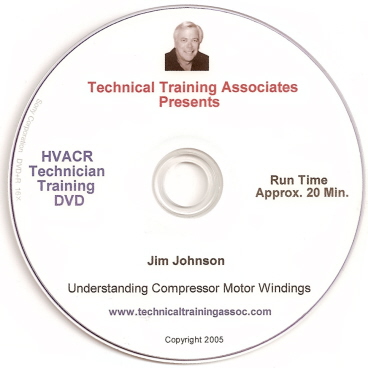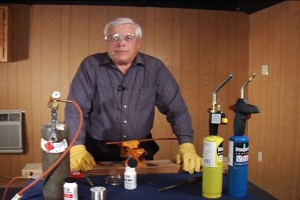Bob got a call from the dispatcher to go to an office building that has a 3-ton heat pump compressor that has been shutting off after startup. The fan would continue to run. The building maintenance man said that he had observed the shutting down of the compressor several times. Bob called the man and told him to turn the system over to emergency heat. Bob wanted to make sure that the compressor had crankcase heat on when he arrived.
Bob arrived at the job and went to the heat pump outdoor unit and removed the compressor compartment door and felt the crankcase. It was hot, so he felt confident to move forward.
Since the compressor had been shutting off, he assumed that the compressor overload was tripping. He placed ammeter jaws around one of the wires entering the outdoor unit to get the total amperage reading of the unit. He then removed the “R” wire from the low voltage terminal block so that he could control the stopping and starting of the outdoor unit.
Bob then went in the building and turned the thermostat to the heat position and out of the emergency heat position. The unit would now be calling for the heat pump to run.
Bob now returned to the unit and replaced the wire on the “R” terminal and the outdoor unit started. It was drawing 20 amps but sounded normal.

Figure 1. This is a typical heat pump outdoor unit nameplate. (Photo courtesy of Bill Johnson.) (Click on the image for an enlarged view.)
Bob was standing there scratching his head when Btu Buddy showed up.
Bob said, “Glad to have you here. I’m confused. This unit is drawing too much current and the compressor overload is tripping after it runs for awhile. The unit seems like it is under some sort of load because it gets louder as it runs.”
Btu Buddy said, “Put the ammeter on the common wire to the compressor and let’s see what the amperage is.”
Bob fastened the ammeter as Btu Buddy suggested and started the unit again with the “R” terminal. The compressor showed 20 amps, then the sound level started up and the amperage rose to 30 amps. Bob then stopped the unit and asked, “What could be causing that rise in amperage?”
Btu Buddy said, “Well, it is obvious that the load is picking up. There are only two loads on the compressor: 1) the compressor bearings, internal friction load, and 2) the compression or pumping load. We can apply gauges to see if it is pumping against too much pressure. If not, we have to believe it is internal friction in the compressor.”
Bob fastened gauges to the system and restarted the unit. The outside temperature was 45°F and the inside, return air temperature was 70°. The suction pressure was 38 psig and the head pressure was 200 psig with the compressor running.
Btu Buddy said, “Those pressures are reasonable. Let’s let it run for a few minutes.”
After it ran for a few minutes, the amperage rose, and the suction and discharge pressures stayed about the same. The noise level picked up again and Bob shut the unit off.
Bob then asked, “What did we see?”
Btu Buddy said, “Feel the compressor where the suction line enters the housing and tell me what you feel.”
Bob felt the compressor and said, “It feels normal. The crankcase seems warm as normal.”
Btu Buddy said, “You can rule out liquid floodback. I believe we can say that this compressor has internal bearing damage and is on the way out. Check the run capacitor just to make sure it is good and I want to start it one more time and listen to the compressor closely as it runs and gets noisy.”
Bob used his capacitor checker and found the capacitor to be good. He then asked, “How are we going to listen to the compressor?”
Btu Buddy said, “Get your longest screwdriver. We are going to use it as a poor man’s stethoscope.”
Bob got the screwdriver and Btu Buddy described what to do. “After starting the compressor, put the screwdriver handle to your ear and carefully place the screwdriver tip to the compressor housing and listen. You will be able to hear what is going on inside the compressor much better. You may want to cover your other ear so that you get the best sound amplification without any background noise.”
Bob started the compressor and then started listening. He got a funny expression on his face and shut the system off. He said, “Boy, it sounds really bad inside the compressor. It sounds like a hard scrubbing of metal to metal.”
Btu Buddy said, “Go ahead and tell the customer that the compressor must be changed. It seems that it is still in warranty so there won’t be too much cost to the customer.”
After the job was finished, Bob asked, “Can you explain RLA amps to me again?”
Btu Buddy said, “RLA stands for rated load amps. This is the maximum amperage that a motor can be allowed to run for extended periods of time. When a motor’s RLA is 20 amps, the motor is running at its maximum. If the load is increased on the motor, damage will start to occur, such as hot spots in the windings that will eventually burn the insulation off of the windings and an electrical short circuit will occur. Conventional motors for fans and pumps have a rating called FLA which is essentially the same as RLA for a compressor.”
Bob said, “This is the first time that I have seen a compressor with an amperage above the RLA rating. Why did the compressor overload trip instead of the breaker?”
Btu Buddy said, “The breaker is for circuit protection, for the wiring. The overload protection is for the compressor motor. The overload protector is set much lower than the circuit protection.”
“Well, I guess I still have a lot to learn,” Bob said.
Btu Buddy said, “Motor protection and circuit protection are a subject of their own. Let’s meet tomorrow and talk about it.”
Publication date:02/21/2011







